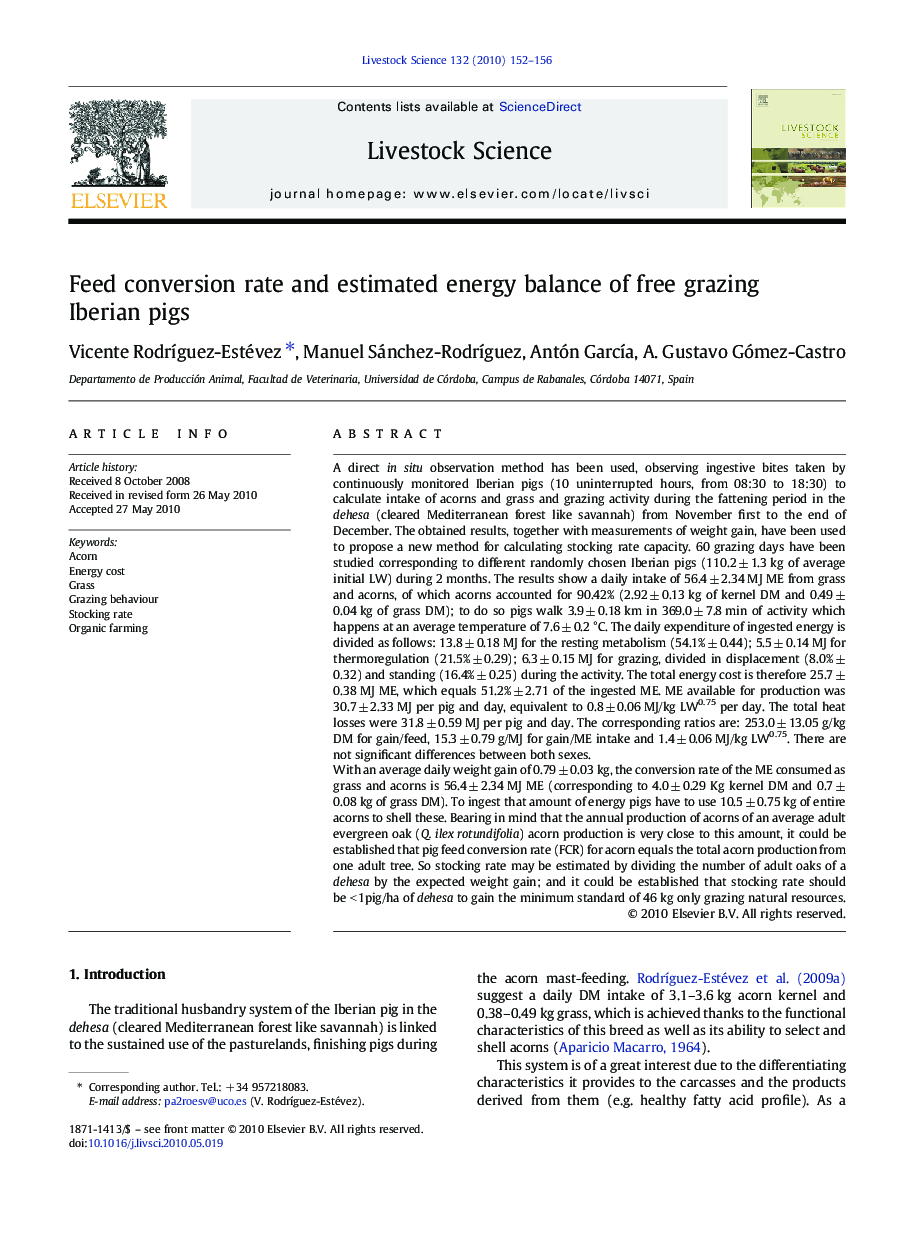| کد مقاله | کد نشریه | سال انتشار | مقاله انگلیسی | نسخه تمام متن |
|---|---|---|---|---|
| 2447765 | 1554000 | 2010 | 5 صفحه PDF | دانلود رایگان |

A direct in situ observation method has been used, observing ingestive bites taken by continuously monitored Iberian pigs (10 uninterrupted hours, from 08:30 to 18:30) to calculate intake of acorns and grass and grazing activity during the fattening period in the dehesa (cleared Mediterranean forest like savannah) from November first to the end of December. The obtained results, together with measurements of weight gain, have been used to propose a new method for calculating stocking rate capacity. 60 grazing days have been studied corresponding to different randomly chosen Iberian pigs (110.2 ± 1.3 kg of average initial LW) during 2 months. The results show a daily intake of 56.4 ± 2.34 MJ ME from grass and acorns, of which acorns accounted for 90.42% (2.92 ± 0.13 kg of kernel DM and 0.49 ± 0.04 kg of grass DM); to do so pigs walk 3.9 ± 0.18 km in 369.0 ± 7.8 min of activity which happens at an average temperature of 7.6 ± 0.2 °C. The daily expenditure of ingested energy is divided as follows: 13.8 ± 0.18 MJ for the resting metabolism (54.1% ± 0.44); 5.5 ± 0.14 MJ for thermoregulation (21.5% ± 0.29); 6.3 ± 0.15 MJ for grazing, divided in displacement (8.0% ± 0.32) and standing (16.4% ± 0.25) during the activity. The total energy cost is therefore 25.7 ± 0.38 MJ ME, which equals 51.2% ± 2.71 of the ingested ME. ME available for production was 30.7 ± 2.33 MJ per pig and day, equivalent to 0.8 ± 0.06 MJ/kg LW0.75 per day. The total heat losses were 31.8 ± 0.59 MJ per pig and day. The corresponding ratios are: 253.0 ± 13.05 g/kg DM for gain/feed, 15.3 ± 0.79 g/MJ for gain/ME intake and 1.4 ± 0.06 MJ/kg LW0.75. There are not significant differences between both sexes.With an average daily weight gain of 0.79 ± 0.03 kg, the conversion rate of the ME consumed as grass and acorns is 56.4 ± 2.34 MJ ME (corresponding to 4.0 ± 0.29 Kg kernel DM and 0.7 ± 0.08 kg of grass DM). To ingest that amount of energy pigs have to use 10.5 ± 0.75 kg of entire acorns to shell these. Bearing in mind that the annual production of acorns of an average adult evergreen oak (Q. ilex rotundifolia) acorn production is very close to this amount, it could be established that pig feed conversion rate (FCR) for acorn equals the total acorn production from one adult tree. So stocking rate may be estimated by dividing the number of adult oaks of a dehesa by the expected weight gain; and it could be established that stocking rate should be < 1pig/ha of dehesa to gain the minimum standard of 46 kg only grazing natural resources.
Journal: Livestock Science - Volume 132, Issues 1–3, August 2010, Pages 152–156